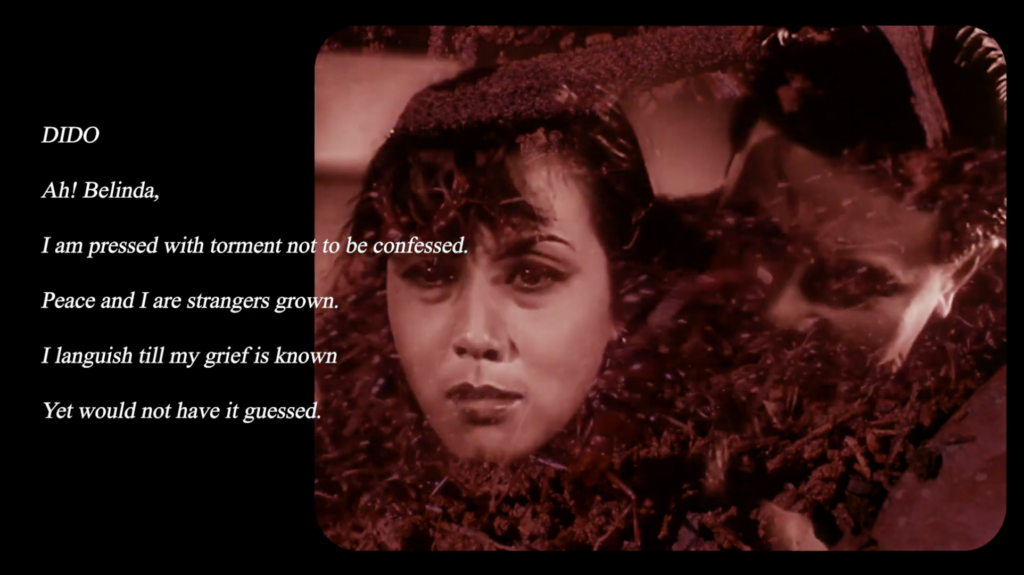
Courtesy of Katharine Li
On screen, Chinese actress Shangguan Yunzhu weeps to an audio backdrop of an Opera Theatre of Yale College actor singing about her grief as Dido, Queen of Carthage — showcasing an unlikely pairing of parallel narratives. Over the weekend, the OTYC premiered their audio-visual production of “Dido and Aeneas” on YouTube Live.
OTYC used a film format to challenge traditional opera viewings in the fall semester show. Directed by Katharine Li ’21, the film combines two analogous narratives: audio for English baroque composer Henry Purcell’s opera “Dido and Aeneas” and visuals symbolizing the alleged romantic affair between Yunzhu and Mao Zedong, founder of the People’s Republic of China. The performers prepared for the show through an intensive semester-long rehearsal and recording process led by musical director Vivian Mayers ’21 and assistant musical director Dani Zanuttini-Frank ’22.
“We came into this project with the intention of … being really innovative in this moment when there are so many restraints,” said cinematographer Annelise Ratner ’23.
In spring 2020, OTYC chose to program “Dido and Aeneas” as their fall semester Baroque opera. The opera, which is based on Book IV of Virgil’s “Aeneid,” tells the tragic story of Dido’s love for Aeneas, and ends in Dido’s suicide when Aeneas leaves her at the bidding of the witches and Sorceress.
According to Mayers, the roles of Dido, Aeneas, Belinda and the Sorceress were precasted to give the soloists adequate time to prepare. The choral parts were casted by audition in late August, and instrumentalists volunteered and were assigned parts.
OTYC initially planned to produce the show as a traditional opera experience. But when the pandemic forecasted an unlikely return for students, Mayers and Li had to rethink their production. Mayers and Emery Kerekes ’21, who played the Sorceress, attended a summer festival called the Oberlin Baroque Performance Institute where they received advice from Joseph Gascho, who had produced a virtual opera in the spring.
With newfound confidence in the possibility of presenting opera virtually, OTYC then decided to separate their audio and visual components to create something “new as it relates to opera,” according to Mayers and Li.
Li proposed playing a “poetic visual” film parallel to their audio narrative, with a montage of images depicting Yunzhu and Zedong’s alleged affair. Ratner used funding from the Creative and Performing Arts Award to gather stock and archival footage to supplement publicly available imagery.
“[Li and Ratner] worked closely throughout the process … to figure out what visual motifs fit each character and their voice, and how to infuse them with meaning and intention,” Ratner said. She added that they used simple techniques of coloring, layering and timing to combat the “detached and impersonal” nature of the stock footage.
Hannah Morrison ’23, who sang alto in the chorus, said the cast followed a strict rehearsal schedule. The group devoted three weeks to each of the three acts. For each act, they spent a week and a half rehearsing and a week and a half recording.
Mayers and Zanuttini-Frank ran daily rehearsals over Zoom and would begin by playing the melody while the cast sang along on mute. Then, each performer would take turns unmuting to understand how their parts fit into the underlying harmonies.
Zanuttini-Frank said that while musicians could not partake in each other’s music or energy — as they could in in-person rehearsals — every player was able to receive feedback in this way. Since the baroque style of playing includes unique musical techniques for each performer, Owen Wheeler ’23 — who played Aeneas — said this “individualized” rehearsal style was effective and “advanced [his] acting, singing and speaking.”
In order to combine the sounds, Mayers and Zanuttini-Frank opted for a layered recording method. Both Wheeler and Kerekes noted that it was challenging to “act into the void.”
“When you’re performing live, you have the grace of leaving it on the stage,” Morrison said. “If it’s a recording, you want it to be your best work … and it’s challenging to stop the impulse to re-record.”
Li hopes their adaptation of “Dido and Aeneas” will contribute to the existing conversations about inclusivity and diversity in theater.
“Opera has always been an artform that has been less accessible — it’s been typically considered less modern, less contemporary, very white, very stodgy,” Li said. “I think this was a really amazing way to relate opera to a medium that is very contemporary, to stories that are more contemporary.”
OTYC, an entirely student-run organization, was founded in 1993.
Samhitha Josyula | samhitha.josyula@yale.edu










